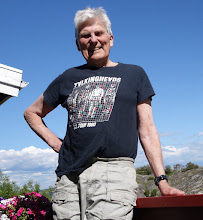I am posting this on TGIF evening here in Sweden just in case any New York Times reader decides to visit my blog after reading my comment on the Cohen article at the URL below
Cohen, following what seems to be standard practice at the New York Times, writes enthusiastically about America's great fossil-fuel future. Each such NYT article faithfully fails to recognize that other countries are making great strides toward making renewable energy a major fraction of their energy production.
In my comment I try to make clear to American readers that they systems here in use on Apelgatan (my street) are preferable to oil and natural gas burner systems, not only because they do not use fossil fuel but also because they are so much more pleasant to have in one's basement than a fire-hazard, fume producing, space demanding (oil tank for example) system.
The picture of the white box I mention in the quoted part of the comment below is to be seen at my November 23, 2010 post. I would like to bring this more up to date here, but not tonight.
If only I could get American readers to tell me why they prefer to have oil or natural gas burners! The first paragraph in my sample below tells you what I thought about those technologies.
I state my basic
reason in very simple terms. I retired to Linköping, Sweden in 1996 and at that
time had an oil burner in the home from which I am writing. That oil burner was
like all those I had in a long lifetime in MA and NY, a pain.
Here in Sweden I was able to switch to distance heating (DH) at the same time (8 years ago) that my neighbor was switching to ground source geothermal (GSG). Since then we have had error free, silent, non polluting heating of home and water while at the same time being able to make our basements just like the rest of the house.
It is -18 C outside and in my basement a small white box 13" x 24" x 38" is taking the heat from the incoming water and keeping me warm-silently! That incoming water has been heated by burning municipal waste-no landfills. My garbage becomes biogas.
Same with GSG-no injection into the ground of contaminants, no air contamination, and renewable forever.
Larry Lundgren Only-NeverInSweden.blogspot.com (pics of that white box)
Here in Sweden I was able to switch to distance heating (DH) at the same time (8 years ago) that my neighbor was switching to ground source geothermal (GSG). Since then we have had error free, silent, non polluting heating of home and water while at the same time being able to make our basements just like the rest of the house.
It is -18 C outside and in my basement a small white box 13" x 24" x 38" is taking the heat from the incoming water and keeping me warm-silently! That incoming water has been heated by burning municipal waste-no landfills. My garbage becomes biogas.
Same with GSG-no injection into the ground of contaminants, no air contamination, and renewable forever.
Larry Lundgren Only-NeverInSweden.blogspot.com (pics of that white box)
http://www.nytimes.com/2012/12/14/opinion/roger-cohen-american-bull.html?hp




















